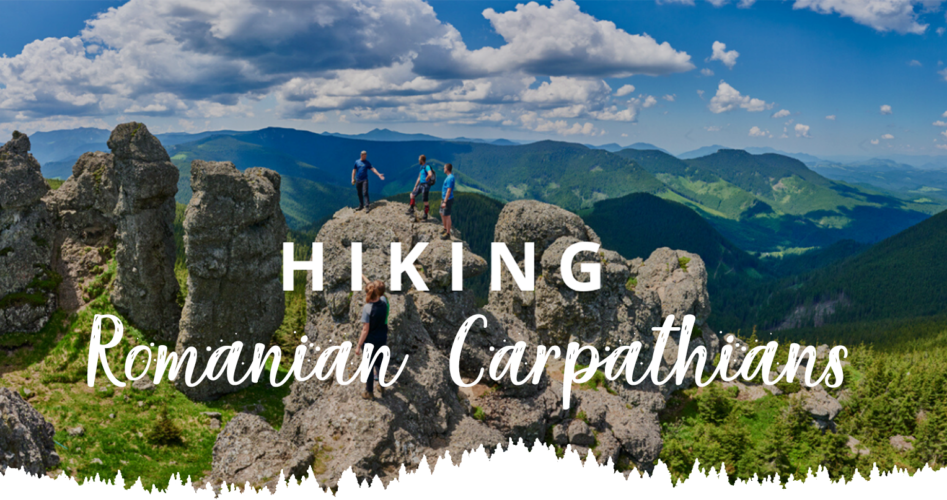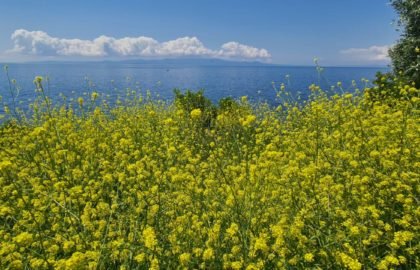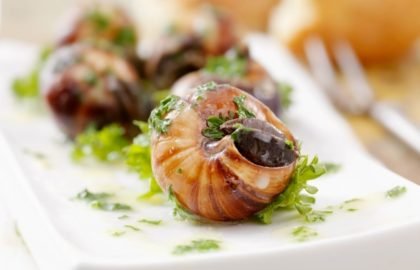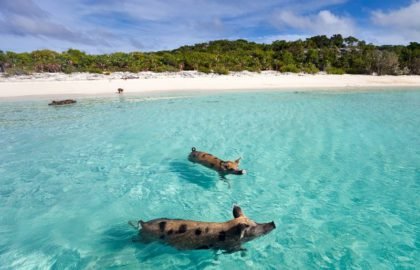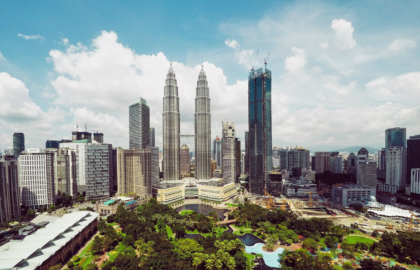[vc_row][vc_column][vc_column_text]
Romania is a country that was blessed with various
and spectacular landforms, from Seaside, Plains, Hills
to lots of Mountains trails.
This article is meant to be a Journey about Hiking trails
which are the most satisfying, degree of difficulty and
and some pieces of advice on places, safety and equipment
that hopefully will come in hand.[/vc_column_text][/vc_column][/vc_row][vc_row][vc_column][vc_single_image image=”553″ img_size=”large” alignment=”center”][/vc_column][/vc_row][vc_row][vc_column][vc_column_text]
There are all kind of paths in the Carpathian Romanian Mountains
for Beginners (that can be very safe and short)
to long and harsh trails – ideal and even challenging to
the most experienced climbers.
The Rumanian mountains are divided in 3 groups:
the Orientals, the Occidentals and Meridionals
In this article we have chosen 5 different peaks
trying to go trough all groups:
Piatra Craiului
Bucegi
Fagaras
Ceahlau
Retezat
[/vc_column_text][/vc_column][/vc_row][vc_row][vc_column][vc_single_image image=”555″ img_size=”large” alignment=”center”][/vc_column][/vc_row][vc_row][vc_column][vc_column_text]
Piatra Craiului
The natural rock fortress of Pietra Craiului is unique among the mountains
in our country. The ridge of about 25 kilometres long forms one of the most
beloved mountain landscapes in Romania, a place where mountaineers,
climbers and researchers alike, can be amazed by the diversity of the place here.[/vc_column_text][/vc_column][/vc_row][vc_row][vc_column][vc_single_image image=”556″ img_size=”large” alignment=”center”][/vc_column][/vc_row][vc_row][vc_column][vc_column_text]
The maximum height of the massif is reached in La om Peak (or Baciului Peak)
which reaches 2,238m. If we leisurely study the peculiarities of the park, we will discover a great variety of shapes and dimensions of the relief: rock corners, needles, pyramids, edges, towers, belts and chimneys. The large number of valleys, rubble, natural arche and alpine gaps complete the visual spectacle, along with particularly spectacular cliffs.
The first nature reserve in Piatra Craiului was established in 1938 and had only
440ha, but in 1972 it doubled its area. The national park was established in 1990 and covers almost 15,000 ha, of which a third is a special conservation area.[/vc_column_text][/vc_column][/vc_row][vc_row][vc_column][vc_single_image image=”557″ img_size=”large” alignment=”center”][/vc_column][/vc_row][vc_row][vc_column][vc_column_text]
The area where the Piatra Craiului National Park take place (ROSCI0194 and ROSPA0165 Piatra Craiului) is located in the Southern Carpathians, including the Piatra Craiului Ridge and the neighbouring intramountain corridor’s Rucar-Bran and Rucar-Zarnesti.
Piatra Craiului National Park and the 2 sites ROSCI0194 Piatra Craiului,
respectively ROSPA0165 Piatra Craiului extend within the counties of Brasov
and Arges, including areas belonging to Zaresti, Moeciu with
Magura and Pestera, Bran, Rucar, Dragoslavele and Dambovicioara villages.[/vc_column_text][/vc_column][/vc_row][vc_row][vc_column][vc_single_image image=”558″ img_size=”large” alignment=”center”][/vc_column][/vc_row][vc_row][vc_column][vc_column_text]
Piatra Craiului National Park stretches around the point with 450 28 ‘north
latitude and 250 16’ east longitude. The total area of the National Park is 14,766 ha, of which 53% in Brasov and 47% in Arges County. The Natural 2000 site ROSCI0194 Piatra Craiului has an area of 15867.04 ha, of which 12834.9 ha overlap on the park area. It completely overlaps with the limits of ROSPA0165 Piatra Craiului.[/vc_column_text][/vc_column][/vc_row][vc_row][vc_column][vc_single_image image=”559″ img_size=”large” alignment=”center”][/vc_column][/vc_row][vc_row][vc_column][vc_column_text]
The richness in species of the Piatra Craiului National Park is the result of the
very varied conditions it offers to the development of the vegetal world. The altitude that exceeds 2200 m makes that almost the entire group of mountain and alpine species to find here optimal conditions for growing and development. The existence of forests, limestone rocks, rubble, meadows and swamp meshes favours the maintenance of a special botanical diversity. Mushrooms, mosses, lichens and flowering plants find a real paradise here. So far, 1199 species and subspecies of plants have been identified on the territory of the park. Knowing the fact that 3136 spontaneous species have been registered in the Romanian flora, it can be stated that the Piatra Craiului National Park hosts 30% of the superior plant species that are found on the Romanian territory. A number of 181 species are included in the “Red List of Superior Plants in Romania” as endemic, rare or vulnerable species. From here you can see the special importance of Piatra Craiului National Park for the conservation of flora species, especially for the conservation of Carpathian endemics.[/vc_column_text][/vc_column][/vc_row][vc_row][vc_column][vc_single_image image=”560″ img_size=”large” alignment=”center”][/vc_column][/vc_row][vc_row][vc_column][vc_column_text]
Of these species we mention only the best known, which delight the eyes of nature lovers, who visit Piatra Craiului in the summer months, these species being subject to a strict protection regime: Piatra Craiului carnation (Dianthus callizonus) the floristic symbol of Piatra Craiului, this mountain being the only place in the world that hosts it (it is an endemic species for Piatra Craiului), yew (Taxus baccata), angelica (Angelica arhangelica), the blood of the warrior (Nigritella rubra), the yellow poppy (Papaver alpinum ssp. corona-sancti-stefani) , linaria (Linaria alpina), corner flower or queen flower (Leontopodium alpinum), bulbous (Trollius europaeus), mountain peony (Rhododendron mytifolium), wild gladiolus (Gladiolus imbricatus), yellow mulberry (Gentiana lutea), iaph blagayana), tulichina (Daphne cneorum), argintica (Dryas octopetala) etc.
Piatra Craiului National Park is home to a large number of species of mountain
orchids – 41 species out of 58 species existing in Romania, but maybe you should see yourself if decide to visit this wonderful places.[/vc_column_text][/vc_column][/vc_row][vc_row][vc_column][vc_single_image image=”561″ img_size=”large” alignment=”center”][/vc_column][/vc_row][vc_row][vc_column][vc_column_text]
Piatra Craiului National Park is one of the most attractive places in the Romanian Carpathians, due to the fact that it houses a multitude of animal species, some of them of Carpathian endemic value. The fauna of the massif, especially the invertebrate species, offers researchers an unsuspected wealth of research possibilities, and large mammals attract lovers of wildlife.
The invertebrate fauna is very rich, presenting a special scientific interest.
It is noteworthy the presence of 35 endemic species and 91 species described here as new to science. We mention two endemic species for Piatra Craiului: Nesticusn constantinescui (Arahnida) and Rhagidia carpatica (Arahnida, Acari). Piatra Craiului is home to a large number of butterfly species, so far over 216 species have been identified, some rare or endemic: Psodos coracinus dioszeghy, an endemic alpine subspecies; Apamea zeta sandorokovacsi, a subspecies endemic to the Carpathians; Erebia pronoe, a species known in the Carpathians only from Piatra Craiului and Bucegi; Pieris bryoniae, species mentioned in the red list of day butterflies in Europe, etc.[/vc_column_text][/vc_column][/vc_row][vc_row][vc_column][vc_single_image image=”562″ img_size=”large” alignment=”center”][/vc_column][/vc_row][vc_row][vc_column][vc_column_text]
Piatra Craiului National Park has a rich ornithofauna, represented by the 112
species identified so far on this territory, from this point of view being an ideal area for bird watching. Although few specimens of mountain eagle can be observed – Aquila chrysaetos, in Piatra Craiului there are other species of diurnal and nocturnal predators. The climatic and geological conditions, the geomorphology and the structure of the flora and vegetation from Piatra Craiului National Park determined the preservation of a special diversity in the group of mammals. Of the approximately 100 species of mammals in the fauna of the entire country, over 40% live in the Piatra Craiului massif. Piatra Craiului National Park hosts a rich population of large carnivores: bear – Ursus arctos, wolf – Canis lupus, razor – Lynx lynx. The deer – Capreolus capreolus and the red deer – Cervus elaphus are found in the forests at the base of the massif. Currently the population of black goats – Rupicapra rupicapra that lives in the rocky areas of the massif is over 200 specimens.[/vc_column_text][/vc_column][/vc_row][vc_row][vc_column][vc_single_image image=”563″ img_size=”large” alignment=”center”][/vc_column][/vc_row][vc_row][vc_column][vc_column_text]
Although we chose these mountains as the first article, no matter how spectacular and diversified Piatra Craiului may be, it stands out with harsh conditions, especially towards the ridge areas, it also has short and friendly trails (Piatra Craiului National Park with over 40 marked routes, 7 refuges) but for the rest, it is not recommended to try them if you are at the beginning/without someone experienced, not properly equipped,
and without some research about routes and weather. The weather on the mountain is very shifty anyway, which requires a minimum of interest
or a phone call to the mountain rescue team for information which can make the difference between survival/comfort/well-being/pleasant memories.
This includes clothing equipment (suitable boots, comfortable and weather-adapted clothing to equipment such as a tent, trekking poles, first aid kit, headband, survival kit, up to water and well-calculated supplies (in most routes on Piatra Craiului, the water sources is an issue from a certain altitude.) The next article will be about Bucegi mountains, we hope this was useful and intriguing, stay safe and see you soon ![/vc_column_text][/vc_column][/vc_row][vc_row][vc_column][vc_single_image image=”564″ img_size=”large” alignment=”center”][/vc_column][/vc_row][vc_row][vc_column][vc_single_image image=”1079″ img_size=”large” alignment=”center” onclick=”custom_link” link=”mailto:contact@relaxaroundtheworld.com”][/vc_column][/vc_row]
Discover more from Relax Around The World
Subscribe to get the latest posts sent to your email.

